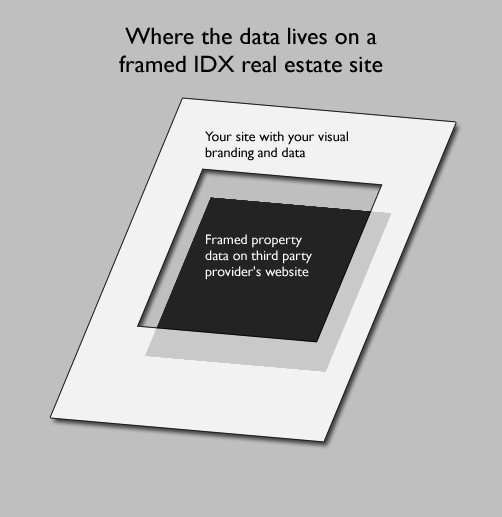Increasing Reach and Engagement: Integrating real estate search technology on your website

Image via Wikipedia
Sean Purcell nails it when he says “the premier ingredient in creating real estate success: lead generation.” Let’s look at how putting property search capability on your site can expand your reach and increase visitor engagement as part of your lead generation activities.
The search function on most real estate professional sites can be broken down into two types: integrated IDX property search and framed IDX property search. Since Union Street Media specializes in IDX integrated real estate web design, we’re often asked what the difference is and which is better.
Framed IDX is often cheaper. But if your real estate website is a part of your online marketing plan, there are significant advantages to an integrated IDX solution that should be considered.
Let’s start by breaking down the components of real estate search technology that matter most to online marketing.
Anatomy of real estate search technology
Search technology for property is a combination of four things:
- Data The MLS data can be hosted on a third party provider or on your site
- Search Interface Flexibility of the search interface to reflect your customers’ desires and your local expertise
- Visual Design Ability to keep your agent or office branding intact throughout your customers’ search process
- Technical Design The code used to display the listings and search results can have implications on your SEO and other marketing objectives
Understanding how these four elements interact can help you make an informed decision about what kind of search technology to deploy on your real estate website.
Your property search and Google
People looking for something will often start on a search engine. The NAR has said that over 80% of housing searches begin online (I bet you’ve heard this from every single technology vendor for the past few months). A fair share of those searches started at Google. You want your property search to be visible to Google in order to reach those people.
From a marketing standpoint, a big difference between integrated IDX and framed IDX is how they appear to Google. On an integrated IDX site, the property data is hosted on your website. That’s part of the integration. On a framed IDX site, the property data is hosted on a third party’s website and “framed” into your site.

Google doesn’t see visual design on websites. It only reads code and data. So while a framed IDX site might appear to be showing all the property data to a human eye, Google doesn’t recognize that the framed data is part of your site. This means that any SEO value from showing property on your site would be lost in a framed IDX site.

Your property search and your brand
Once people find your real estate search website, the next thing you’ll be wanting to do is provide them with an engaging experience. Engaging experience is web marketing geekspeak for “help them find stuff by making the search easy and effective.”
The design of a framed IDX search is often shared across a vast number of real estate websites. This can make integrating the design and branding of your office site with your search technology difficult.
Integrated IDX sites inherit the design styling of your site because the data is on your site. For this reason, it is often easier to maintain branding consistency on your site with an integrated IDX property search.
Widgets and other real estate tools
Integrated IDX sites also offer the capability to add widgets such as a quick search on every page of your website, easily configurable one-click real estate searches and other tools that you can use to promote property and encourage visitor interaction with your search technology. You’ll also want the ability to add extra information to your own listings on your site (if your MLS allows this) so that you don’t get a “duplicate content” penalty from Google. Some framed IDX searches offer these things and some don’t.
These extra tools and widgets have become more prominent and important in the past year as a way for agents and offices to differentiate their specialty knowledge in a geographic region, customer type or property type.
Some questions to ask your real estate search technology provider
Choosing the right technology for your real estate website will always come down to weighing the costs against the benefits. Here are some questions to ask your technology vendor (whether you’re using integrated IDX or framed IDX) so you can plan your online marketing efforts accordingly:
- Will Google and other search engines consider the property information part of my site for SEO purposes?
- Can I change the design and color scheme of the list and detail views to match my site’s branding?
- Can I set up one-click searches and provide links from anywhere in my existing site?
- What incentive do you have to improve your search technology in the future?
- Can I show extra information about my property that is only on my site (avoiding duplicate content issues with Google)?
If you found this article helpful, you may also be interested in the “Is your code hurting your website” post.


Thanks for the great article, I never knew how important the structure of an IDX meant to the search engines!
Thanks for stopping by Jennifer. The structure of the IDX is important but even more important is the difference between the data actually being integrated with your website vs being framed in. That and the ability to enhance your own listings (avoiding duplicate content with all the other people integrating IDX).
Good luck and thanks for stopping by.
This makes perfect sense! You have good ideas here and I will bookmark this site and click here again to see what else I can learn. Thanks!
with the real estate market hopefully picking up maybe I can hire a new assistant and have time to keep up with my blog
This is such a great resource that you are providing and you give it away for free. I enjoy seeing websites that understand the value of providing a prime resource for free. I truly loved reading your post. Thanks! Flatshare Brighton Team!
How do you feel about Google doing away with a lot of real estate search terms from Google places and how this will change the techniques that we use to target local markets for our clients?